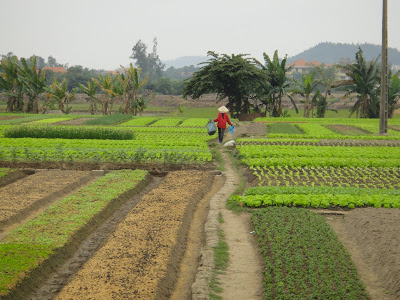 Driving through the Red River Delta en route to Ha Long Bay from Hanoi was fascinating and terrifying. Fascinating: we passed a motorbike carrying about 100 live chickens in baskets, then another with ducks, and finally one carrying five small pigs in a basket across the back wheel! Terrifying: we drove most of the way on the wrong side of the road, weaving in and out of oncoming traffic. One time in particular, we tried to pass the two lanes of traffic going our direction by driving on the wrong side heading toward an oncoming 18-wheeler, which was passing a sedan. HONK HONK! beeped the sedan, flashing its lights. MMMRRRRR MMMMRRRRRRR! blasted the 18-wheeler, flashing it’s lights and accelerating. MEEP! ME ME MEEP! tooted our car, also accelerating. This game of chicken concluded when the cars we were trying to pass finally relented and slowed down a little, giving us just enough time to scrape back onto our side of the freeway. You know how when you’re almost in an accident or pass a cop when you’re speeding a lot and all your blood rushes to your head and you can’t feel your feet? I was so scared I was light-headed and nauseous for the next 10 minutes. I’d also just read that more tourists are killed in car accidents in Vietnam than any other way. I mentioned that to our guide later. He didn’t say anything.
Driving through the Red River Delta en route to Ha Long Bay from Hanoi was fascinating and terrifying. Fascinating: we passed a motorbike carrying about 100 live chickens in baskets, then another with ducks, and finally one carrying five small pigs in a basket across the back wheel! Terrifying: we drove most of the way on the wrong side of the road, weaving in and out of oncoming traffic. One time in particular, we tried to pass the two lanes of traffic going our direction by driving on the wrong side heading toward an oncoming 18-wheeler, which was passing a sedan. HONK HONK! beeped the sedan, flashing its lights. MMMRRRRR MMMMRRRRRRR! blasted the 18-wheeler, flashing it’s lights and accelerating. MEEP! ME ME MEEP! tooted our car, also accelerating. This game of chicken concluded when the cars we were trying to pass finally relented and slowed down a little, giving us just enough time to scrape back onto our side of the freeway. You know how when you’re almost in an accident or pass a cop when you’re speeding a lot and all your blood rushes to your head and you can’t feel your feet? I was so scared I was light-headed and nauseous for the next 10 minutes. I’d also just read that more tourists are killed in car accidents in Vietnam than any other way. I mentioned that to our guide later. He didn’t say anything. 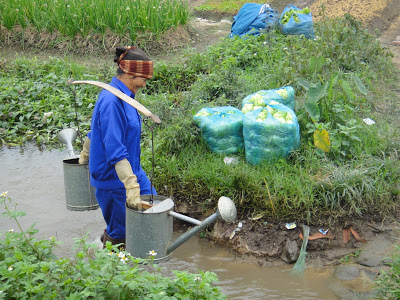
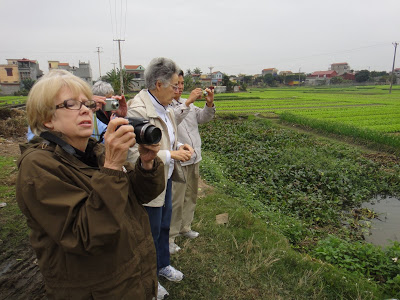 Our driver stopped near some ladies watering and harvesting chartreuse cabbage fields. After we’d been there a few minutes a German tourist bus headed the other direction pulled over. Being part of a huge group of tourists all taking pictures of these ladies hard at work felt so wrong, so I took a picture of the other tourists, too. ha ha. I wonder if all the tour companies subsidise these fields for tourists. Either way, they look a lot like all the other farms in the Red River Delta.
Our driver stopped near some ladies watering and harvesting chartreuse cabbage fields. After we’d been there a few minutes a German tourist bus headed the other direction pulled over. Being part of a huge group of tourists all taking pictures of these ladies hard at work felt so wrong, so I took a picture of the other tourists, too. ha ha. I wonder if all the tour companies subsidise these fields for tourists. Either way, they look a lot like all the other farms in the Red River Delta.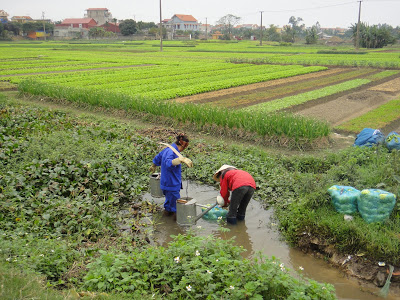
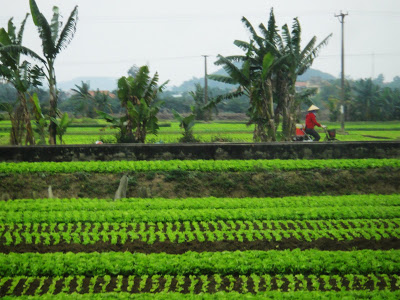
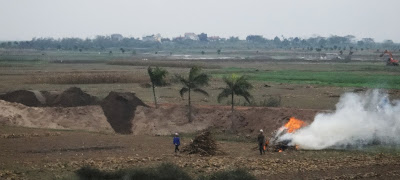 We passed through a town nicknamed “Black City” because the coal mines nearby have covered the entire town in a layer of black dust. Even the trees are black. It felt weirdly like driving through an old black and white photo. Predictably, there’s a lot of lung cancer here. We passed farmers burning stuff after the harvest in their fields and boys chattering to each other from the backs of their water buffalo and tons of garment factories. I asked Fu’oo if the average worker’s $100/month wage can support a family. He said if the family lives frugally in the country, yes, but not in the city, and not if they’re trying to send anyone to school. Usually multiple family members work, and sometimes since the war, multiple families even live together. We passed concrete houses with corrugated tin roofs and several funeral processions, one waving little white flags. Vietnamese like to be buried in rice fields and many people are buried in their own, or even in their own backyards. After about four years, the bones are dug up (after dark, because cooler temperatures make decomposition gasses less toxic) and put in a small, permanent coffin for re-interment. Every cemetery has two sections for this purpose—the decomposing section and the permanent section. “Sometimes they can’t be sure they have the right bones,” Fu’oo shrugged.
We passed through a town nicknamed “Black City” because the coal mines nearby have covered the entire town in a layer of black dust. Even the trees are black. It felt weirdly like driving through an old black and white photo. Predictably, there’s a lot of lung cancer here. We passed farmers burning stuff after the harvest in their fields and boys chattering to each other from the backs of their water buffalo and tons of garment factories. I asked Fu’oo if the average worker’s $100/month wage can support a family. He said if the family lives frugally in the country, yes, but not in the city, and not if they’re trying to send anyone to school. Usually multiple family members work, and sometimes since the war, multiple families even live together. We passed concrete houses with corrugated tin roofs and several funeral processions, one waving little white flags. Vietnamese like to be buried in rice fields and many people are buried in their own, or even in their own backyards. After about four years, the bones are dug up (after dark, because cooler temperatures make decomposition gasses less toxic) and put in a small, permanent coffin for re-interment. Every cemetery has two sections for this purpose—the decomposing section and the permanent section. “Sometimes they can’t be sure they have the right bones,” Fu’oo shrugged. 
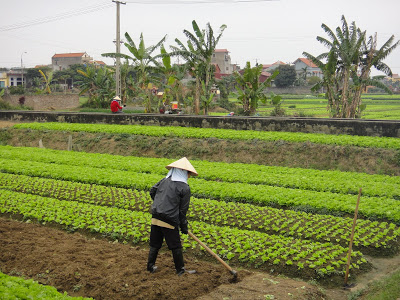
Where Globe-Trotting meets Beach-Combing
